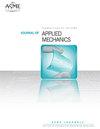Surface effect in nano-scale fretting contact problems
IF 2.8
4区 工程技术
Q2 MECHANICS
引用次数: 0
Abstract
The fretting contact behavior of nanomaterials is significantly influenced by surface effect. A model of fretting contact between a nano-sized rigid cylindrical indenter and an elastic half-plane is established based on Gurtin-Murdoch (G-M) surface elasticity theory, with which the surface effects on the stress and displacement distributions and the size of stick region in the contact zone are studied. It is found that the surface effect induces an additional traction besides the external force applied by punch, which leads to smoother stress and displacement distributions. The normal surface-induced traction related to the residual surface stress is opposite to the externally applied compression, which results in a material stiffening in the contact zone so that the contact radius, normal displacement and normal stress decrease compared with classical predictions. The tangential surface-induced traction is opposite to the externally applied frictional stress, leading to reductions of the shear stress and tangential displacement in the contact zone. Furthermore, the surface effect leads to three possible states in the contact zone, including complete slip, partial slip and complete stick, instead of the solely partial slip state in classical fretting contact models. Among them, the complete stick is more beneficial for inhibiting the wear of contact devices, which can be realized by reducing the indenter size. The present research does not only help ones to better understand the physical mechanism in nano-scale fretting contact problems, but should also guide the anti-wear design in nano-electro-mechanical (NEMs) systems.纳米微动接触问题中的表面效应
纳米材料的微动接触行为受到表面效应的显著影响。基于Gurtin-Murdoch (G-M)表面弹性理论,建立了纳米刚性圆柱压头与弹性半平面的微动接触模型,研究了表面对接触区应力、位移分布和粘块区域大小的影响。研究发现,除了冲头施加的外力外,表面效应还会产生额外的牵引力,从而使应力和位移分布更加平滑。与残余表面应力相关的法向表面诱导牵引力与外部施加的压缩相反,这导致材料在接触区变硬,因此与经典预测相比,接触半径、法向位移和法向应力减小。切向表面诱导的牵引力与外部施加的摩擦应力相反,导致接触区切应力和切向位移的减小。此外,表面效应导致接触区出现完全滑移、部分滑移和完全粘着三种可能的状态,而不是经典微动接触模型中单纯的部分滑移状态。其中,完整棒更有利于抑制接触装置的磨损,这可以通过减小压头尺寸来实现。本文的研究不仅有助于人们更好地理解纳米微动接触问题的物理机制,而且对纳米机电系统的抗磨设计具有指导意义。
本文章由计算机程序翻译,如有差异,请以英文原文为准。
求助全文
约1分钟内获得全文
求助全文
来源期刊
CiteScore
4.80
自引率
3.80%
发文量
95
审稿时长
5.8 months
期刊介绍:
All areas of theoretical and applied mechanics including, but not limited to: Aerodynamics; Aeroelasticity; Biomechanics; Boundary layers; Composite materials; Computational mechanics; Constitutive modeling of materials; Dynamics; Elasticity; Experimental mechanics; Flow and fracture; Heat transport in fluid flows; Hydraulics; Impact; Internal flow; Mechanical properties of materials; Mechanics of shocks; Micromechanics; Nanomechanics; Plasticity; Stress analysis; Structures; Thermodynamics of materials and in flowing fluids; Thermo-mechanics; Turbulence; Vibration; Wave propagation

 求助内容:
求助内容: 应助结果提醒方式:
应助结果提醒方式:


